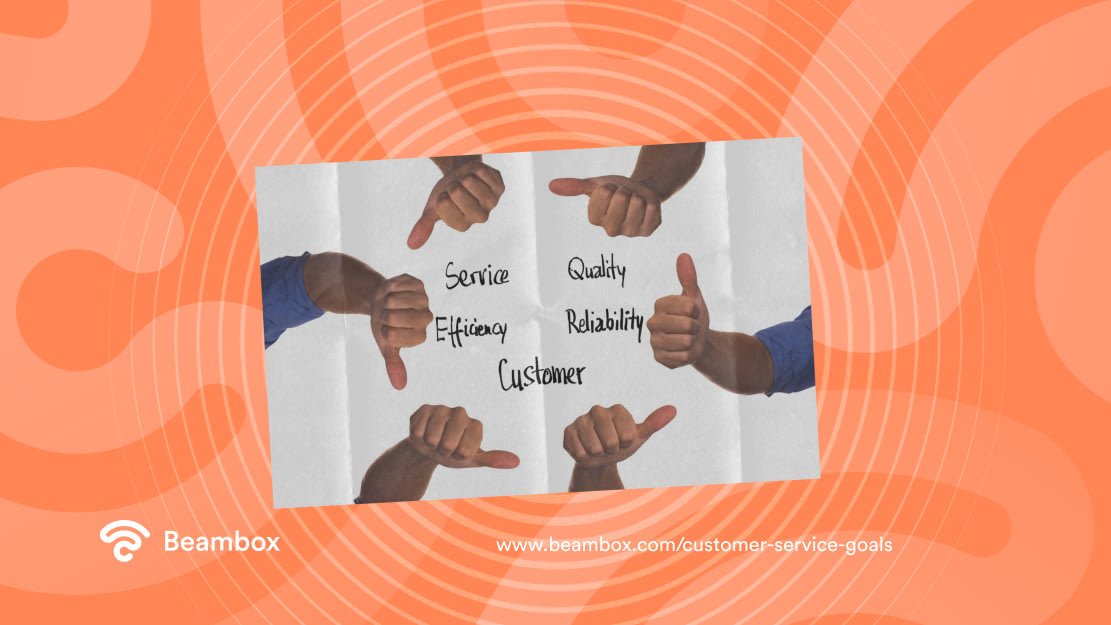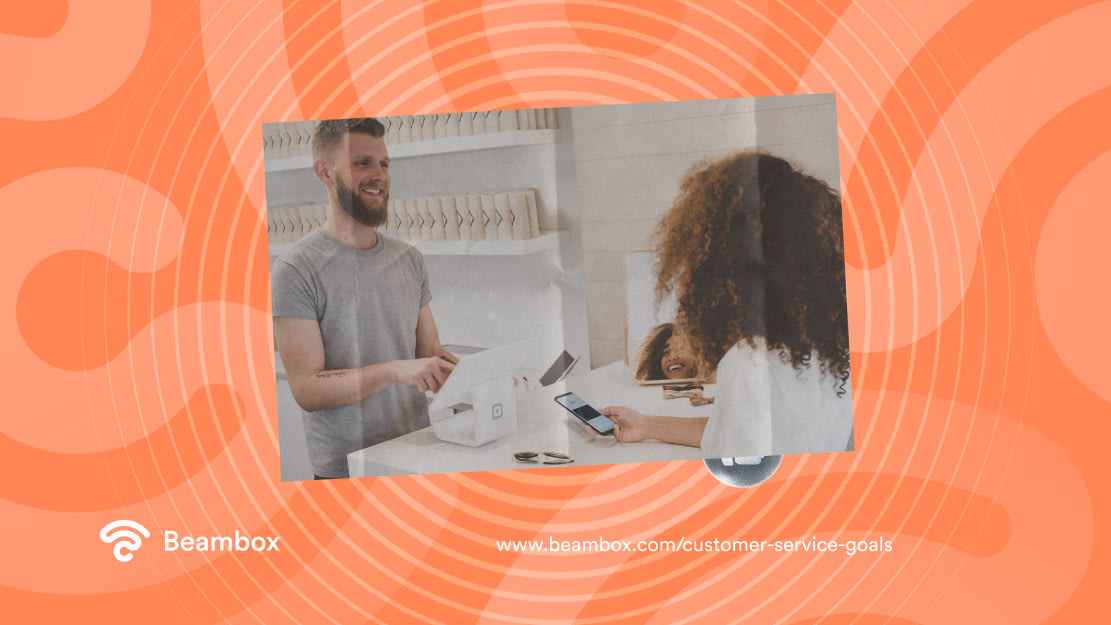Customer Service Goals: What They Are and How To Meet Them
Customer care is where you get the foundations of any successful business. No matter what you think of your business and its operations, the only opinion that truly matters is your customers. And customers vote with their cash. With all this considered, having customer service goals is a valuable way to strive for success.
These goals could be anything from increasing customer satisfaction, measuring by survey, or customer retention. There are many ways to measure customer satisfaction levels; there’s more than one way to skin a goat. You could use surveys, Google reviews, verbal feedback, or stats like customer retention and repeat customers.
The underlying thing to remember is the better you can connect with customers, the more success your business will see.
In this guide, we’ll break down the importance of having goals for customer service. These goals could be as simple or complex as you like (hello, SMART goal setting), but they help you connect overall.
We’ll cover a straight definition, benefits, the importance of customer experience, and how to fit goal-setting into wider campaigns. You’ll be an expert in no time!

What Are Customer Service Goals?
These are just customer care goals, measurable things you strive for. For instance, you can achieve better customer experiences through more positive Google reviews. A customer service strategy is the real secret to success. It helps you recognize where there’s room for improvement, motivate yourself, and maintain accountability through concrete milestones.
You could set customer service goals around getting better reviews or verbal feedback. You could improve customer service based on your existing knowledge of your target audience. For example, add an aesthetic photo wall because your customers love snapping shots on nights out.
These don’t just have to be goals you make when starting a new slate, either. You could have goals for customer recovery — an excellent strategy for building customer loyalty. Did you know that the average company loses 10-25% of its customers yearly? Pretty morbid, right? Just imagine the difference you could make.
Customer service goals are things that you can shift to improve your business and its future. They improve your customers’ experiences and boost your profit. The goals are always measurable and action-orientated, whether installing a photo wall or measuring retention rates.
Does that sound simple enough? Now you’ve got a solid definition, it’s time for us to move forward and evaluate why you should even care. Keep that shocking 10-25% customer loss a year in mind.

The Top 7 Reasons Why Customer Experience Matters
Guest experience is everything. Some businesses, like restaurants, rely on customer service for long-term business growth. You just cannot get more customers over the threshold without happy customers first leaving. Reviews spread fast, and managing your online reputation is essential to your customer service strategy.
Every business owner and customer service team knows the power of an unhappy customer. In the worst scenarios, you brace yourself for them to leave negative reviews before they’re even fully out the door. It’s a horrible feeling.
Maintaining excellent customer service can sometimes feel like an uphill battle, especially in the face of day-to-day adversities.
However, we don’t often focus on the flip side: the importance of positive customer experiences. Yes, it’s essential to manage the negative experiences and flip frowns into satisfied customers. But let’s focus on the positives, the seven leading ways happy customers can boost your business:
- They can leave positive reviews on Google and TripAdvisor.
- If they enjoyed their experience, they may give word-of-mouth recommendations to friends.
- Happier customers are more likely to return, providing you with repeat profit.
- Positive interactions give your staff a boost.
- Smiling, laughing, and appreciative customers create a warm atmosphere to attract more guests.
- They may engage with your socials.
- Happy guests are more likely to sign up for loyalty programs.
How To Invest in Short Term vs Long Term Goals for Customer Service
One thing we would keep in mind is the difference between short-term and long-term goals for customer service. For instance, a short-term goal might be to put up a photo wall for an aesthetic display. However, a long-term goal might be to attract more people to your bar for cocktails and drinks, not just restaurant meals.
Usually, there’s a link between your short-term and long-term goals. Depending on your strengths and weaknesses, practicing scaling up and reducing them can be helpful.
If you need help pinpointing actions and feel overwhelmed by big ideas, practice breaking long-term goals into short-term actions. If you find it harder to look beyond smaller actions, practice identifying your long-term goals.
Having a mixture of both long and short-term goals is great. You just have to invest in them differently. For instance, for long-term goals, you’d:
- Identify pain points through customer feedback, your business model and its profitability, or market research.
- Establish solutions or a solution.
- Crunch your budget and finalize a vision.
- Create small, actionable steps as short-term goals.
For example, for short-term goals, you’d:
- Draft your idea.
- Analyze your budget and price up for your idea and any necessary expenses.
- Identify what the immediate gain is and whether this solves or interacts with any long-term pain points.
It’s much easier to start from long-term goals and narrow them down. But with that said, if you have a short-term idea (like that photo wall installation), go wild! It certainly adds more creativity to the process of doing it “in reverse.” You just have to make sure that there’s an immediate and long-term gain.

3 Reasons To Invest in Goals: Motivating Yourself and Your Staff
There are so many reasons to invest in customer experience goals. If you take your business seriously, it’s a must. Customer service improvement is a surefire way to set yourself up for success. It’s a reactionary yet thoughtful process, and if you’re just starting, congratulations on taking a smart step.
In this section, we’ll give you all the inspiration you need. Did someone say motivation? Here are three reasons that will provide you with bucketloads.
1. Positive Customer Experiences Are Marketing Investments
This is single-handedly the most important thing for you to understand. Satisfied customers are an investment. They are some of your most valuable assets in your marketing scheme. Why? Because happy mouths talk, but unhappy mouths talk louder.
It’s a fact that customers are more likely to share negative than positive experiences. Psychologically speaking, this is likely due to their heightened emotional responses at the time. However, to balance that out and protect your reputation, you need many more positive guest experiences than negative ones.
Everyone wants to see reviews before purchasing or booking. One of the huge positives of happy customers is that they sometimes leave glowing reviews and feedback. They’re also marketing investments differently, like word-of-mouth recommendations and repeat customers.
Ensuring guests have a positive experience is one of your greatest marketing investments.
2. Goal Setting Encourages You To Consider Customer Insights
By setting goals, you have to reflect and listen. You’ll know as well as anyone how hard it is as customer service agents or business owners to reflect calmly. Most customer interactions are fleeting and at your busiest times.
The precious thing about goal setting is that it naturally encourages you to consider customer insights and plan accordingly. You might finally get to look at reviews, mull over what those ladies told you, and crunch demographics.
These are all great ahead of making business changes and help you remain savvy and customer-focused.
3. Setting Goals Hold You Accountable
Setting goals is all about holding yourself accountable. It ensures that you will achieve the bigger things you want to achieve, just one step at a time.
It’s not about laziness. There are so many reasons why you might not hold yourself accountable, such as:
- Exhaustion.
- Overwhelm.
- An incompatible schedule.
- Friends, family, colleagues, or peers with different priorities.
- Lack of understanding.
- An inability to turn dreams into action.
- Poor time planning and management.
You prioritize your customer service by setting goals and planning how you’ll meet them. This way, you’ll get more out of your hard work and make things easier for yourself. You should be your own cheerleader — not your own worst enemy.
This also applies to your customer service team. Keep them inspired and clear on how to achieve business goals.

3 Customer Service Goals Examples
Are you struggling to know where to start with all these customer experience goals? It’s very easy. You just look at your biggest pain point and limiting factor. This could be seating, decor, food quality, wait times — or maybe something else entirely.
If you’re still stuck, nab some of these examples. Here are three customer service goals examples to get your clogs whirring.
1. Building Customer Satisfaction Over Restaurant Wait Times
This is a tricky one. Building customer satisfaction over wait times is a great idea as a long-term goal. But it will definitely need narrowing down. Here’s how we’d do it:
- Evaluate staffing numbers. Is there adequate staff on the rota at all times?
- Evaluate prep. Are you taking most walk-ins? Is there a way to encourage bookings? Or could chefs prep more beforehand?
- Could you make the wait more pleasant? Is there a complimentary drink or activity you could provide?
- Can you find a solid reason why restaurant wait times are longer at your establishment? How do you portray this to encourage your guests to appreciate this?
You could hire more staff, set chef prepping guidance, use booking systems, and give customers complimentary bread or olives.
2. Increase Customer Retention
Increasing customer retention is so important. This is a great long-term goal and is easy to tackle. There are just a few things to consider:
- Why are you losing most of your customers? Is there a recurring pattern or reason? Exit surveys are a great way to find out.
- What are the standard retention vs. loss rates for your industry? You may not be doing as badly as you think.
- What service are you currently providing, and what are its pain points?
- Have your customers told you things that are putting them off becoming repeat customers? If not, can you ask them or check with your staff?
You could invest in post-experience surveys (perhaps incentivizing customers), identify and address service pain points, and speak to staff. Loyalty programs and training staff in conflict resolution are also great ideas.
3. Create a Friendlier Atmosphere
You can see how this could be overwhelming, especially considering the mania of certain environments like fast food venues. We must break this goal down for clarity and actionability. You could ask yourself and the staff:
- How do you define a friendlier atmosphere? What would it entail?
- Could you adjust your business layout?
- Are there adjustments staff could make?
- Could you encourage more foot traffic for specific customer types?
As a solution, you might adjust seating to communal tables, run events, train staff, and target specific customers through marketing.

Building Customer Service SMART Goals: Examples
Knowing how to build SMART goals is valuable. SMART stands for specific, measurable, attainable, relevant, and time-bound. If you want more structure in your goal setting, this acronym is for you.
We’ll run you through two examples of customer service smart goals to give you an idea of how they work.
Reducing Wait Times by 10 Minutes Before the End of the Month
This goal is to reduce wait times by ten minutes by increasing kitchen prep, hiring two new staff members, and requiring bookings.
This is specific as it specifies the unit of time (ten minutes). It’s measurable as it uses minutes as a reference point and attainable as the solution is relative to the task. It’s relevant, as clearly, this is a pain point for the business. And it’s also time-bound, presenting a deadline of the end of the month.
Increase Customer Retention by 10% by January 2025
This goal is to increase customer retention by training staff in conflict resolution, running exit surveys, and analyzing pain points.
This is specific as it can identify the percentage increase (10%). As a percentage, this is measurable. It is attainable, as the proposed solutions are reasonably parallel to the scale of the goal. It’s a relevant pain point for the business, with an evident time frame for January 2025.

What Strategies To Link Goals for Customer Service With
You can link customer satisfaction goals with so many other strategies. This is mainly because you need feedback to create these goals. You can’t pull this from thin air; you need real insights from honest customers.
Email surveys are great as long as you already have their email address. Of course, this may not be the case, especially with new customers. In that case, we’d suggest the following.
QR code marketing and feedback forms are a great strategy to complement service goal strategies. As we said, how can you improve your customer experience without accessing real customer insights? The best way to tackle this across the board is on the spot. You can use QR code prompts to offer rewards in exchange for customer feedback.
WiFi marketing is another strong point. It helps you collect customer insights that can benefit you and help you reach customer service goals. All you need is a captive portal system — more on that in a second.
Beambox: How WiFi Boosts Customer Service
WiFi is incredible for customer service. Firstly, even just offering WiFi gets you in the good books. There’s a massive demand for WiFi in all today’s businesses, and by offering quality WiFi, guests are immediately happier. See it as providing a more rounded and fulfilling service.
It also allows you to use a captive portal to collect customer feedback. A captive portal is a web page pop-up software you can attach to your existing WiFi. It’s super affordable, with rates starting at around $25 on a monthly subscription.
In exchange, you can temporarily block guests from immediate WiFi access until they comply with your web page requests. If you’re concentrating on customer service goals, you could request feedback and insights into customers’ experiences.
You can see how it’s so effective. At Beambox, we provide all-in-one WiFi marketing software with a captive portal for feedback collection.
Start your Beambox free trial today and transform your approach to customer service goals!



